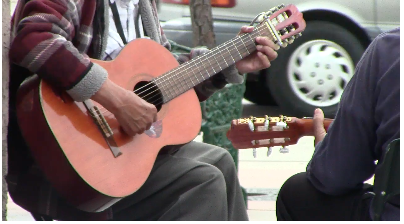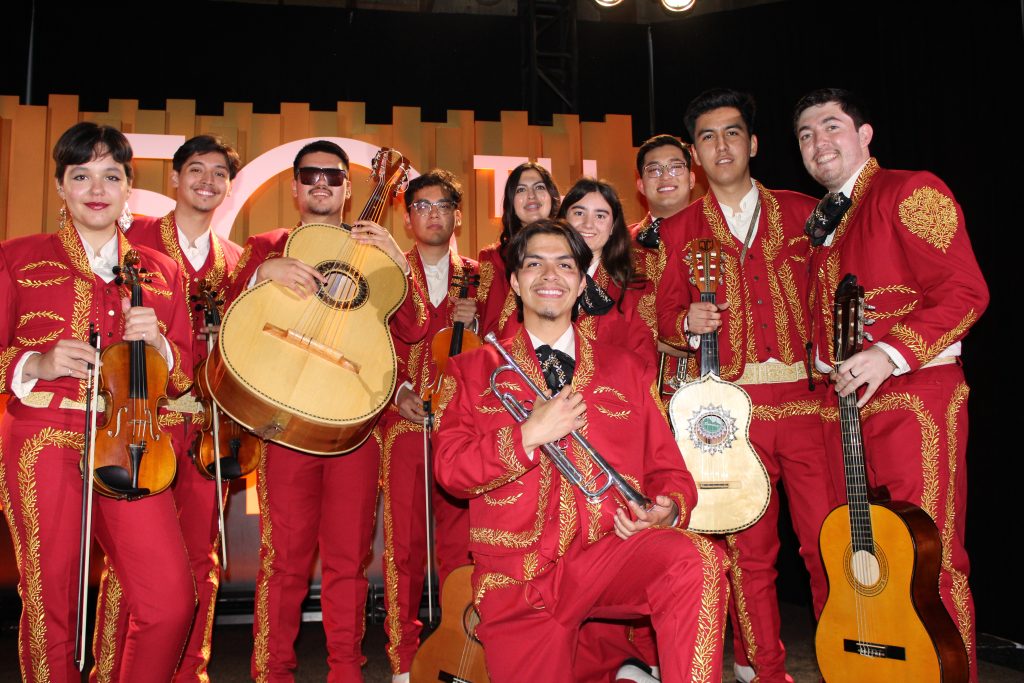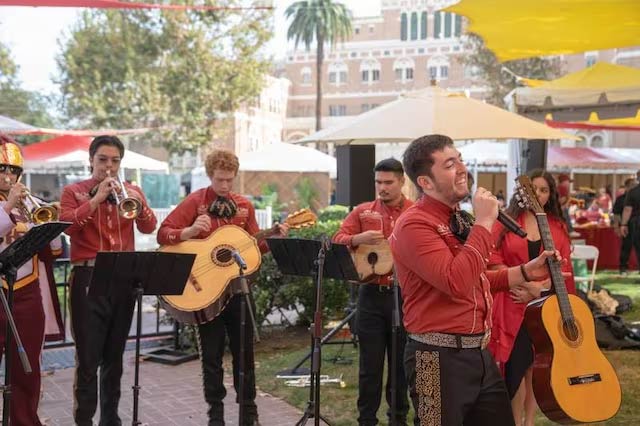Fighting to maintain a cultural tradition: Mariachis overcome barriers for the love of their music
In spite of numerous struggles new generations continue the love for Mariachi music
By José Romo
A 30-minute ride connects the Downtown Los Angeles area with the vibrant Boyle Heights community. Upon walking out of the underground metro station you are welcomed by the sight of murals, construction and most importantly, the sound of Mariachi music.
Staple of Mexican culture, La Plaza del Mariachi serves as the anchor of tradition for musicians of all backgrounds that gather in hopes of earning a day’s work through their craft. Walking through the plaza you see numerous trucks; all with phone numbers painted on the back window drawing attention to the need for gigs. Mariachis sit patiently on the plaza benches playing cards, others use this space to rehearse some music, some even leave in a hurry trying to beat traffic in order to attend their latest jobsite.
The weekends hold the highest likelihood for Mariachis to be hired. Most families host parties; weddings, baptisms, birthdays and even simple family gatherings. All of these events require live music and for those with great musical taste, Mariachi music is perfect. While most Mariachis look to find gigs, some find it nice to just go to the plaza and play their music.
Teodoro Cuevas, owner of Mariachi Estrella del Sur, shared his knowledge to future generations of Mariachi musicians. “La verdad no soy maestro pero se tocar. Tengo mi grupo de Mariachi,” said Cuevas, humbly alluding to his own Mariachi by recounting how he likes to jam to the rhythm of his guitar. After coming to the United States in 1970, Cuevas began to work in the long-haul trucking industry. He recalls not ever considering a career in music since none of his siblings played an instrument.

Upon retirement, Cuevas found himself in a pickle; sit back and watch time pass or enjoy the music of Mariachi. At 65 years old, Cuevas started to learn how to play the guitar. Now he totals the knowledge of four different instruments; the guitarron, the vihuela, the requinto, and of course the guitar. “Yo trabaje en Los Ángeles hasta mi retiro de vejez y nunca toque un instrumento. Pero ya vez que dicen el hambre es el que tumba y el orgullo levanta,” Cuevas joked saying that hunger is quick to drop you, but it is your pride that picks you back up. His solution at the time was to do what he continues to do to this day, pull up a chair and play with his friends. “Empecé a venir aquí y fui aprendiendo y ahora resulta que tengo mi propio Mariachi,” Cuevas added that he learned from the musicians he would meet at the plaza.
“Pienso que todos los que sabemos el arte pasamos por dificultades. Los compañeros te hacen menos, pero la persistencia es la que cuenta,” he said that musicians go through many hardships, yet it’s persistence that keeps them going.
Cuevas told me that often his concerns stem from the lack of lighting in the streets of Boyle Heights. There are times he feels unsafe, he says. He then went on to say that some Mariachis even take business competition as far as to tell clients that certain Mariachis are not worth the investment. However, the continuation of the Mariachi tradition is not all that Cuevas has in mind. The community as a whole faces a growing housing crisis.
In 2018, Mariachis found themselves struggling to make ends meet after their rent was spiked. Cuevas recalls that when he first moved to East Los Angeles rent prices were completely different. “En ese edificio que estaba ahí vivían la mayor parte de Mariachi y pagaban $400, $300. Ahora está muy caro porque se remodelaron y pues ya no viven Mariachis. Ya no cualquier persona puede pagar $1400,$1300,” said Cuevas referencing the over $1000 spike in rent. Jaime Gomez, who was sitting with Cuevas for a lesson while I was conducting the interview, told us he worked in the remodeling of the building where Monarca Bakery sits now. “Lo cambiamos todo y ahora hay menos apartamentos,” said Gomez in a remorseful tone to the changes that now leaves his own community with less housing.
Located on East Second Street, the building served as more than just a roof for Mariachis, it was a music sanctuary. Cuevas recalls his own experience with the housing crisis. “En ese tiempo había más facilidad. Yo vivo en el Este de Los Ángeles. Ya se empezaron a escanciar (las viviendas),” said Cuevas. Back then, Cuevas was able to delve into the realtor business as both a homeowner and a landlord. He bought a small house and then purchased two small joint apartments which he began to rent off on Hoover and Adams. “Cuando llegué, empecé con $2000 y vi que estaban muy baratas las casas. Entonces entre Adams y Hoover yo compre unos apartamentos.” For Cuevas, his early investment made it easier for him to continue his run with Mariachi music.
Alejandro Cuevas, leader of Organización de Mariachis Independientes de California (OMICAL), says that the growing rent prices have pushed him and his colleagues away from the Plaza. “Ya no hay donde parquearnos. Llegamos en la madrugada y viene uno con el temor que te asalten ya que te vienes estacionando lejos de la plaza o de donde vives,” he says that there is a risk of being mugged when returning at late hours of the night from work.
Cuevas adds that that the community of Boyle Heights serves as, “una fuente de trabajos;“ a source of jobs. “Esta es una plaza donde se juntan los Mariachis y donde llegan los clientes,” he says. Cuevas feels that the ongoing housing crisis and the height of the pandemic made it even harder for Mariachis within the community. “Con esto que se atravesó del covid, si estaba triste mucha gente murió. Estuvimos ayudando con dispensas y gastos fúnebres de los fallecidos,” Cuevas added that his organization continues to help other mariachis with food and rent aid programs.
Test your Mariachi Knowledge
Alejandro Cuevas, leader of Organización de Mariachis Independientes de California (OMICAL), says that the growing rent prices have pushed him and his colleagues away from the Plaza. “Ya no hay donde parquearnos. Llegamos en la madrugada y viene uno con el temor que te asalten ya que te vienes estacionando lejos de la plaza o de donde vives,” he says. The overall move of Mariachis away from
Cuevas adds that that the community of Boyle Heights serves as, “una fuente de trabajos;“ a source of jobs. “Esta es una plaza donde se juntan los mariachis y donde llegan los clientes,” he says. Cuevas feels that the ongoing housing crisis and the height of the pandemic made it even harder for Mariachis within the community. “Con esto que se atravesó del covid, si estaba triste mucha gente murió. Estuvimos ayudando con dispensas y gastos fúnebres de los fallecidos,” Cuevas added.
Continuing the Legacy
Being from Jalisco, Mariachi music runs through my veins. It was always my dream to be a part of a Mariachi and in my sophomore year of college I decided to join with other students in creating Mariachi Los Troyanos de USC. Three years later, this club has not only won awards and gained recognition, but it also turned into a family that prides itself on highlighting our Mexican heritage. As I move closer to graduation I look at the future Troyanos who will continue this legacy.
Similarly, professional Mariachis continue their own legacies having generations on generations practicing the tradition of their music. That is how the majority of Mariachi music is passed on. Grandparents teach their children who then teach their kids, continuing the chain of musicians. While Cuevas is an exception to this motif he still sees this happening within the community. Feeling proud that this tradition continued Cuevas said, “Yo estoy mirando que muchos Mariachis están entrenando a sus hijos. Es una gran alegría porque así no se perderá la costumbre,” stating that he sees other parents teaching their kids and is proud to know that the legacy will continue.
Eduardo Cardenas, a fourth generation Mariachi, is one who keeps the tradition alive. “I never wanted Mariachi to be my career path. Around five years ago I picked up the violin for the first time, started working with my dad and I haven’t looked back since,” said Cardenas. Coming from such a talented household, Cardenas felt he was destined to continue the family tradition, “Seeing what a talented family I come from, it was hard to deny that this was something I needed in my life. I think being in front of a crowd and playing something that you are proud of, something that you practiced a lot, I think there is no better feeling than that.”

However, despite the beautiful tradition, Cardenas has a few conflicts with its societal practice. “It’s such a difficult industry and there is no guarantee that you have work or that it’ll be enough to cover rent and food,” Cardenas says, adding that he has yet to know a single Mariachi member who has contributed to their retirement. “There are just weekends where my father just doesn’t have work and I’ve been fortunate enough to always have food on the table.”
Above all that, Cardenas feels that in hindsight working with a Mariachi was not the best for someone who started at a highschool age. ”There’s not many jobs in the world where you show up and the first thing they offer you is a shot. I’ve been able to use the excuse that I’m not 21 for a long time, but there have been clients who have been intoxicated enough to let their judgment go and get aggressive,” he said.
Having seen the hardships of Mariachi culture, Cardenas still feels it is a beautiful tradition that shouldn’t be forgotten. “I truly do think that Mariachi is the most beautiful thing in the world,” he says. Cardenas now serves as the president for Mariachi Los Troyanos de USC where he continues this legacy on a university campus. “I think that the fact that we are able to have such a cultural statement, especially at a PWI, I think it truly is something beautiful,” says Cardenas. He adds that he is proud to provide a space for students to explore their Latinidad. Cardenas acknowledges that not everything is a bed of roses, but still the recognition received on campus leaves hope for Latino representation. “Although we’ve experienced being victims of tokenism from time to time, I think for the most part we are truly appreciated and valued at this institution,” he says. “I do hope that it’s something that spans generations and that a foundation is met to continue for a long time.”

Yet, the future is now and a number of schools in the city of Downey have worked to foster the Mariachi tradition by providing school music programs. Elizabeth Varela, mother of Raul Varela, mentions she has seen a lot of growth in her son thanks to these programs. “I really like it mostly because it helped his language skills,” she said, adding that she was surprised by his interest in Mariachi. “We don’t speak too much Spanish at home so it helps him learn the language along with the culture of the Mariachi.” Her son, a member of the DUSD mariachi, recalls his start with the genre. “I started listening to a couple of songs on the radio and El Rey by Vicente came on and I loved it. And luckily with the help of (mom) we found the DUSD Mariachi program,” he said.
Raul Velazquez, Director of Mariachi Herencia Michoacana mentioned he worked to start an afterschool music program in order to provide better skill sets for youth eager to learn Mariachi music. “Hay muchos jóvenes que quieren aprender pero no hay suficientes oportunidades para que ellos sigan practicando su música,” he states that his daughter participated in a similar program that didn’t offer the same growth that Mariachi Herencia Michoacana has now achieved. In the last four years their group has grown to 12 members and two instructors.
Christian Diaz, a 19 year-old vihuela and guitarron player for Mariachi Herencia Michoacana confessed that prior to joining the group, he really didn’t like Mariachi music too much. “My parents would always play Mariachi music in the mornings and I would just think, ‘turn the music off please,’” he said. Diaz adds that he now hopes to continue learning more instruments and singing some songs in the group’s next performances.
The tradition continues with more students joining similar programs. Like Velazquez likes to mention, “El Mariachi viene siendo una tradición de nuestros antepasados, pero que es muy arraigada en los mexicanos.” Mariachi music is a tradition of our ancestors, he says, with a smile growing on his face, adding that it is very rooted in Mexican culture. “Eso lo traen ya en la sangre los muchachos, por eso es que … hay veces que su idioma, el principal idioma es el inglés y cuando empiezan a calar el instrumento es una satisfacción. Se les ilumina el rostro cuando ven que pueden dominar el instrumento y eso es satisfactorio para todos,” Velazquez states that while Spanish may not be the main language for a lot of these kids, music is universal and many of these youth carry the Mariachi culture in their veins.